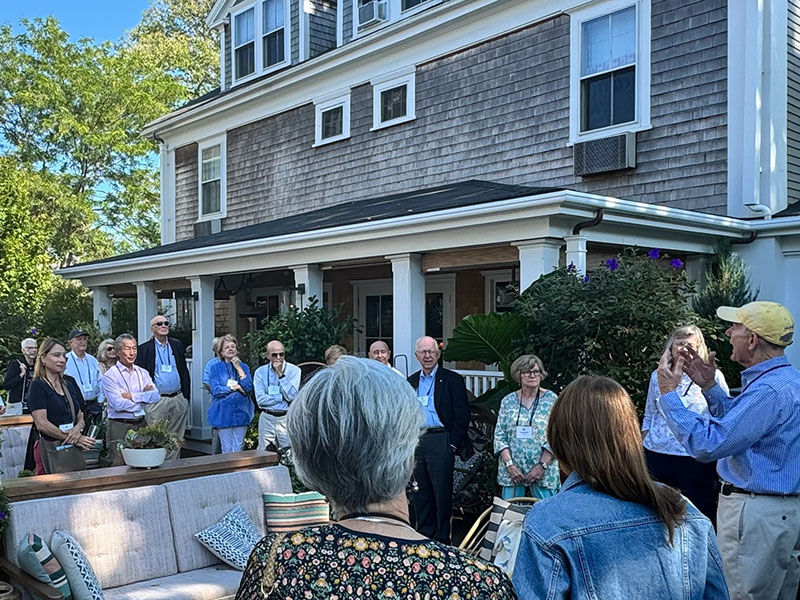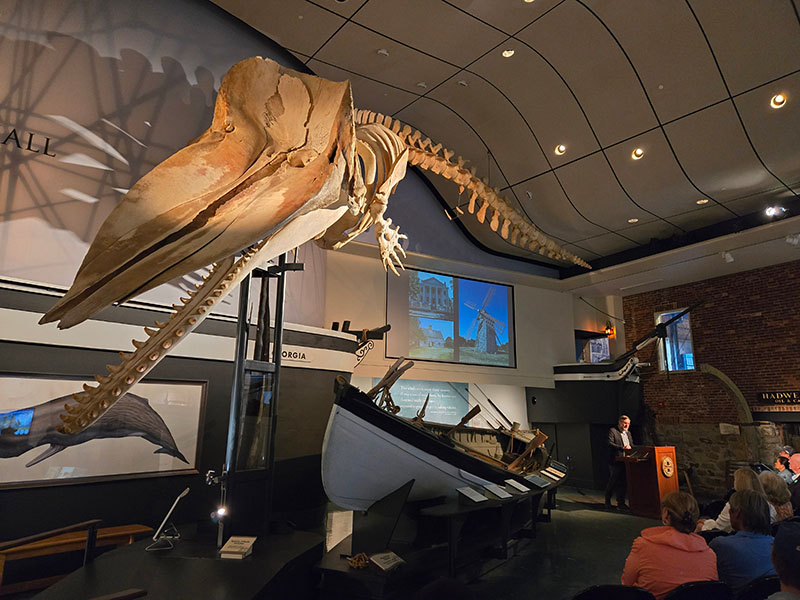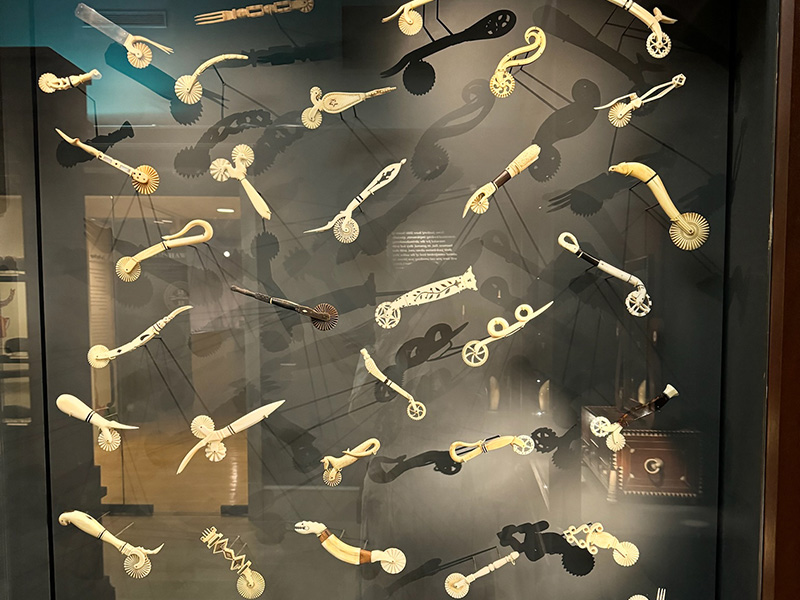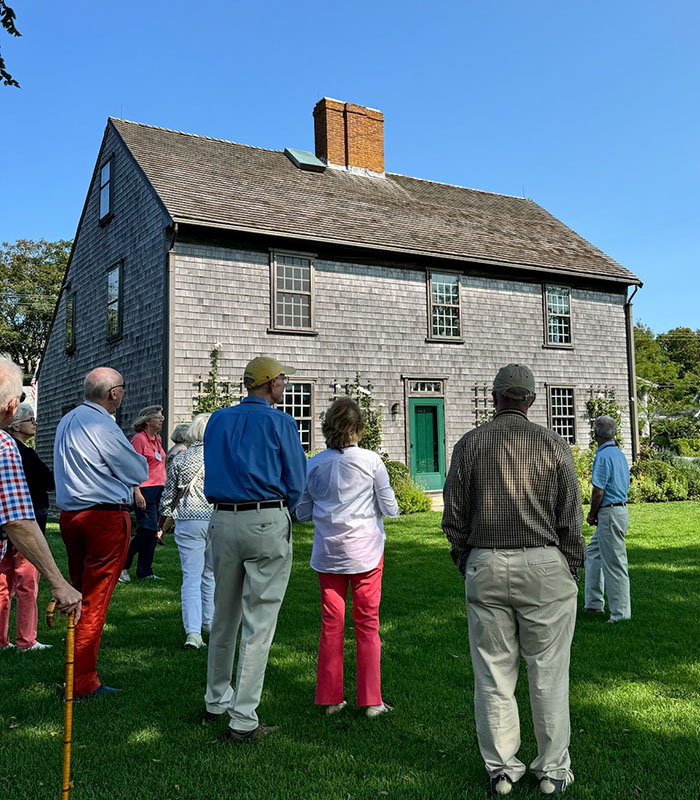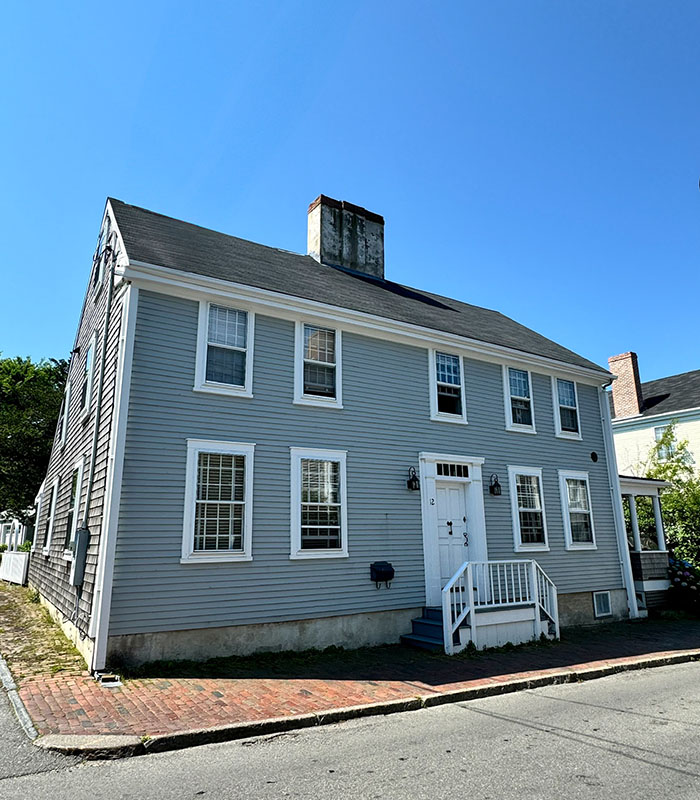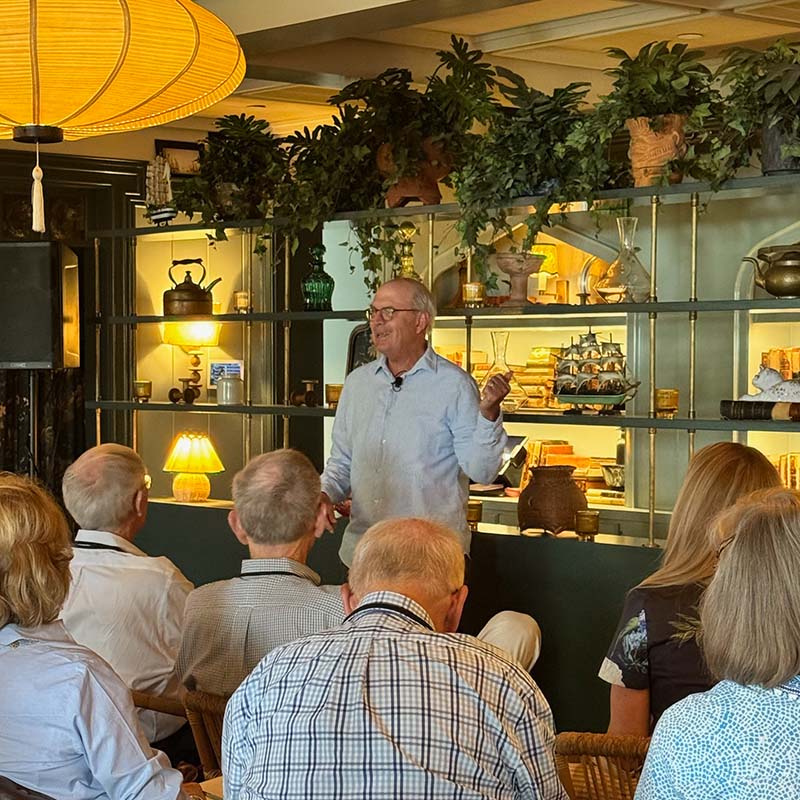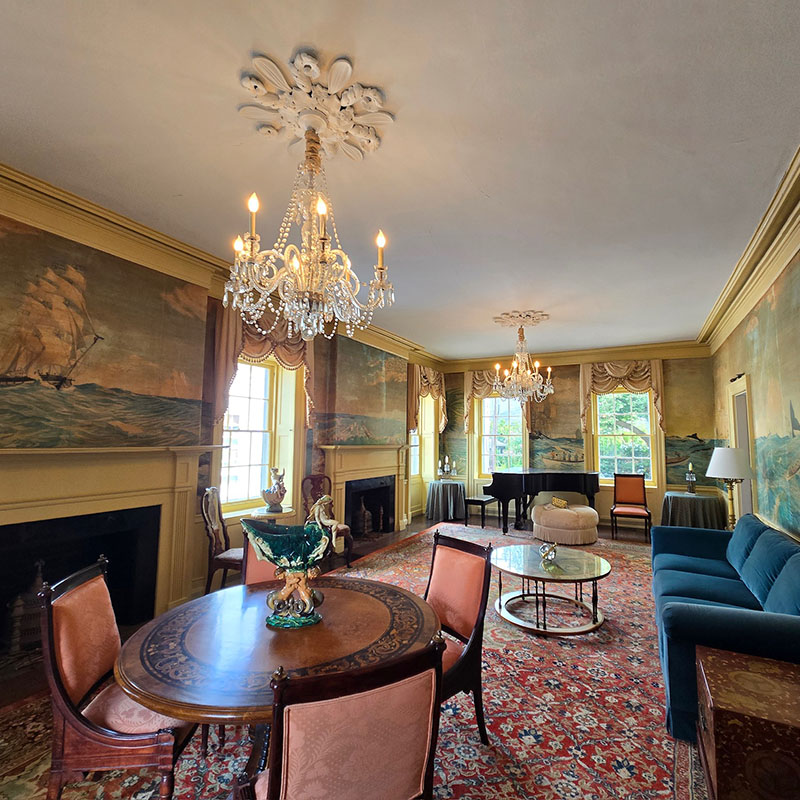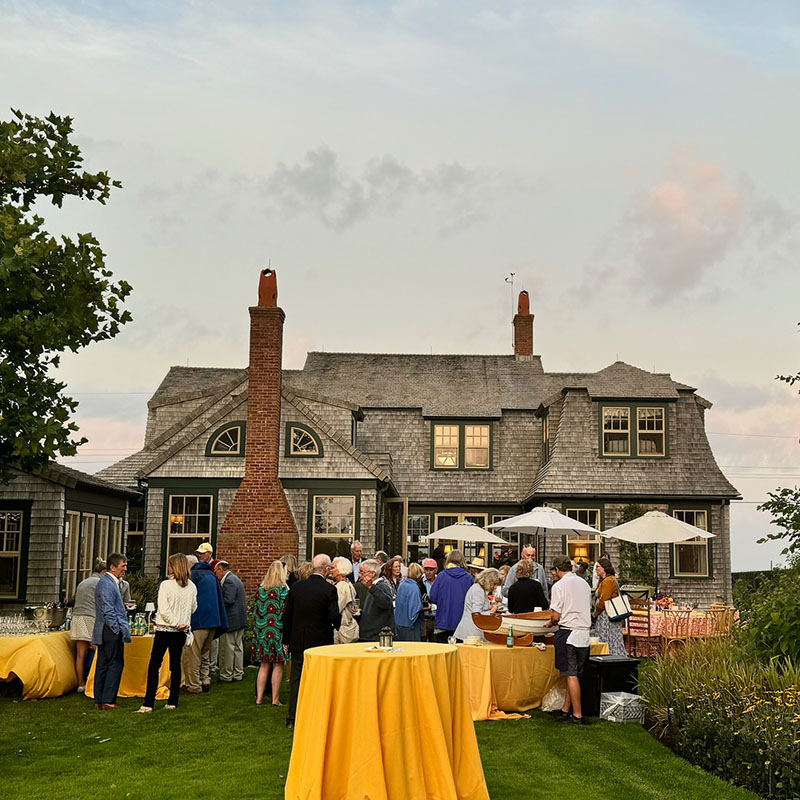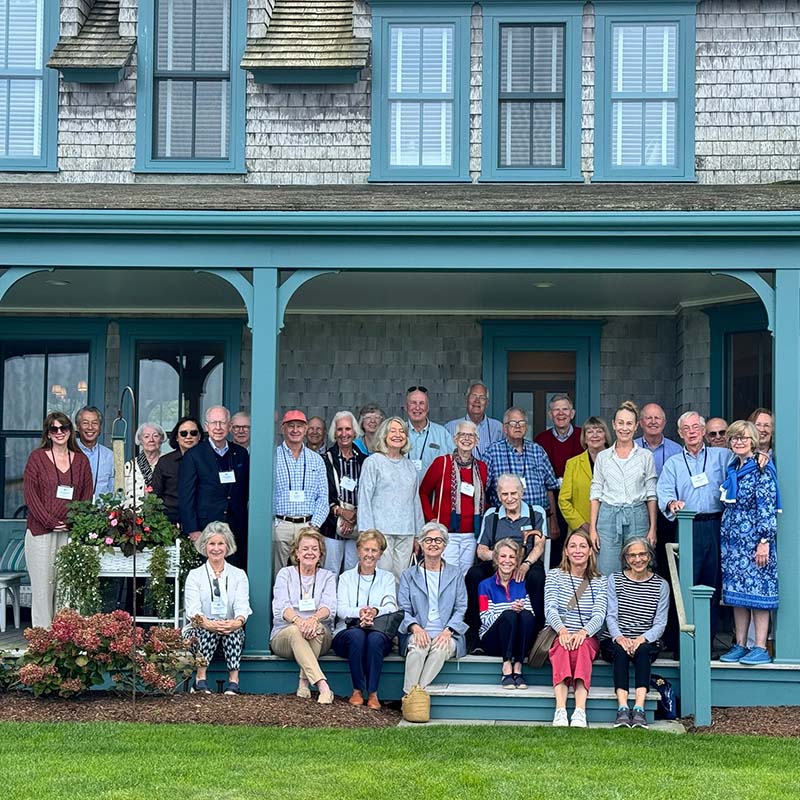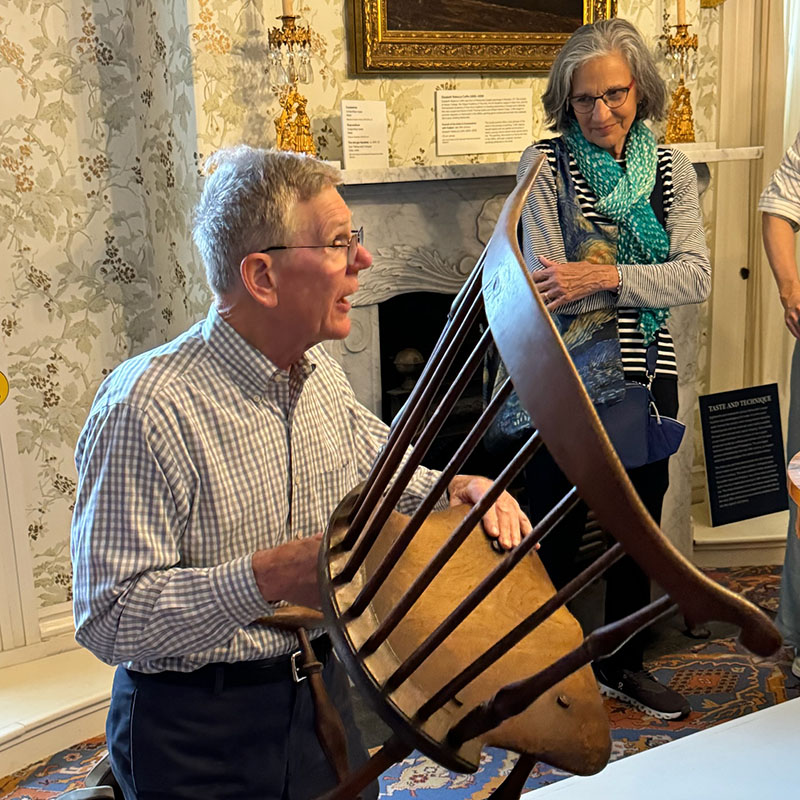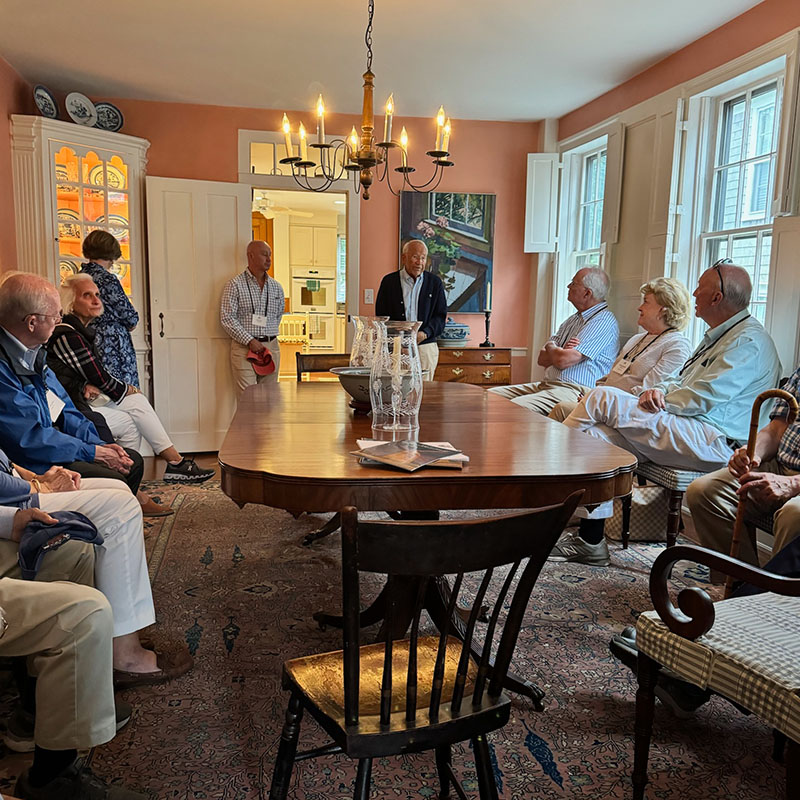Nantucket’s Arts, Architecture, Cuisine, and Scenic Vistas Dazzle Members
This sold-out program kicked off on Wednesday, September 4, with welcoming remarks from furniture expert Brock Jobe, Trust Board President and Winterthur Professor of American Decorative Arts Emeritus, at the lovely Faraway Hotel, our headquarters for the weekend (figure 1). The Nantucket Historical Association’s Whaling Museum was the site of an introductory lecture by Michael Harrison, the Museum’s Chief Curator and Obed Macy Research Chair (figure 2). Michael took members onto the rooftop of the museum to enjoy glorious views over the harbor and orient the group within the historical area. Explorations of the museum’s collection revealed a treasure trove of locally made furniture, intricate scrimshaw, and early portraits of merchants and sea captains (figure 3). Cocktails in the Faraway’s courtyard were followed by a fun and filling dinner in Sister Ship Restaurant.
Thursday Exploring Downtown and Beyond
The first full day of the Sojourn began with tours of the Oldest House (figure 4), also known as the Jethro Coffin House. Built in 1686, the structure is believed to be the oldest residence on Nantucket still on its original site. The nearby 1722 Richard Gardner II house (figure 5) is one of Nantucket’s oldest remaining lean-to houses and has been given fresh life for its next 300 years by the current owners. It has recently been recognized with an Architectural Preservation Award from the Nantucket Preservation Trust.
Members enjoyed the First Congregational Church, whose hilltop location makes it one of the first buildings visitors see when arriving by ferry. The church was begun in the early 18th century, with the Old North Vestry constructed by 1725 and the larger sanctuary built in 1834. Those who climbed all 93 stairs into the church steeple enjoyed matchless panoramic views of the island. We continued to visit two properties with noteworthy history and ownership, by kind arrangement with Hampton Lynch and April Russell. The Nathaniel Starbuck House and Thomas Starbuck House were built for members of the same prominent whaling family, and both were relocated from other areas of the island in the late 18th century to their current position next door to each other.
The nearby Thomas Macy House (figure 6) was built c. 1800 as a modest dwelling and then underwent a significant transformation in the 1830s under the ownership of Thomas Macy and his wife, Eunice Coffin, daughter of the wealthy whale-oil merchant Zenas Coffin. Michael Harrison interpreted the site for us and then provided a walking tour of significant architecture along Main Street as we made our way to the Nathaniel Macy House, built by Thomas Macy and deeded to his youngest son, Nathaniel, in 1745. It now serves as the residence of the NHA’s Gosnell Executive Director, Niles Parker, who welcomed us in grand fashion with drinks and a fresh raw bar of oysters and clams.
Friday Sites Around Town and in ‘Sconset
Following an amusing and insightful lecture by Nathaniel Philbrick, the Pulitzer Prize finalist and author of In the Heart of the Sea and Away Off Shore (figure 7), the group departed for Moor’s End, a c. 1834 house with stunning interiors (figure 8). The remarkable and expansive gardens were full of color, and the beautiful 1920s murals in the dining room tell the story of the local whaling industry.
We then had the unique opportunity to visit Blueberry Hill, the home of Caroline Ellis and her late husband, Doug, who have lovingly cared for their special home and garden within a conservation easement near Polpis Harbor.
Arriving in Siasconset (known as ‘Sconset), participants were greeted by Mary Bergman, Executive Director of the Nantucket Preservation Trust, who showed us standout sites around the village. The Siasconset Union Chapel was built in 1883 as an ecumenical “House of Worship” and has hosted Protestant and Catholic services ever since. We particularly enjoyed examining their kneeling cushions, each of which feature charming needlepoint scenes of Nantucket designed by one of the island’s most cherished artists, Erica Wilson. An elegant New England lunch was hosted at the Chanticleer, a mainstay of ‘Sconset since the turn of the century. The Siasconset Casino was established in 1899 as a “Hall of Amusement,” with plans by architect John Collins. We admired the interior patterned latticework, added in the 1920s and inspired by the Newport Casino. Our stroll along the dramatic ’Sconset Bluff Walk introduced a path that has played a significant role in local history since the Wampanoag people used it for navigation and hunting. In the 1870s, William Flagg, a summer resident, acquired the land, and in 1892, he ensured public access by deeding a portion of the bluff specifically “for residents and visitors…as a footpath or foot promenade.” The Bluff Walk passes directly behind a number of historic fishing cottages like Nonantum, built in 1791 by Barzillai Folger. We had the special opportunity to see how this early residence has been thoughtfully redesigned for a modern family. The fulsome day ended in grand style with drinks, dinner, and lots of laughter at the beautiful ‘Sconset home of Trust Members Martha Dippell and Danny Korengold (figure 9). They have filled Four Is Enough with local objects, personal treasures, and family heirlooms, making for a warm and spirited conclusion to our day on the east side of Nantucket.
Saturday Experiencing Nantucket’s Artistry
Our final day on the island opened at the 1830s Nantucket Atheneum, where special objects from the library’s collections were put on display to showcase the island’s civic and intellectual history. Afterward, a privileged visit to the home of Max and Pam Berry at the tip of Brant Point was a true highlight: their superb and expansive collection of Nantucket material culture was head-spinning and jaw-dropping, made all the more memorable by the delightful couple’s amusing stories from collecting over the years (figure 10). In the afternoon, a visit to the 1846 Hadwen House included a furniture object study with Brock Jobe (figure 11), insights into the lightship basket gallery with Michael Harrison, and a basket weaving demonstration. Janet and Keith Lindgren kindly invited us into their home, the Joseph Myrick House, a 1790 Quaker home with a beautiful collection and garden (figure 12). Melinda and Paul Sullivan’s exquisite Levi Starbuck House, constructed in 1837, was the first example of Greek Revival residential architecture built on the island and is now home to their fine collection of Du Paquier porcelain, Old Master paintings, and Degas sculptures. Saturday’s adventures concluded with a celebratory lobster dinner overlooking the harbor, where we toasted a memorable exploration of Nantucket!
Between the history and art and the company and cuisine, we cannot deny that this Sojourn was a winner! Learn about the Decorative Arts Trust’s upcoming Sojourns and other programs on our Calendar of Events. We invite those interested in Sojourns to become a member at the Ambassador or Champion level, as these levels receive early registration benefits, and our programs fill quickly!
About The Decorative Arts Trust Bulletin
Formerly known as the "blog,” the Bulletin features new research and scholarship, travelogues, book reviews, and museum and gallery exhibitions. The Bulletin complements The Magazine of the Decorative Arts Trust, our biannual members publication.
Click Images to Enlarge
Did you know that clicking on the images in Bulletin posts will allow you to get a closer look? Simply click on an image, and a larger version will open in a pop-up window.








